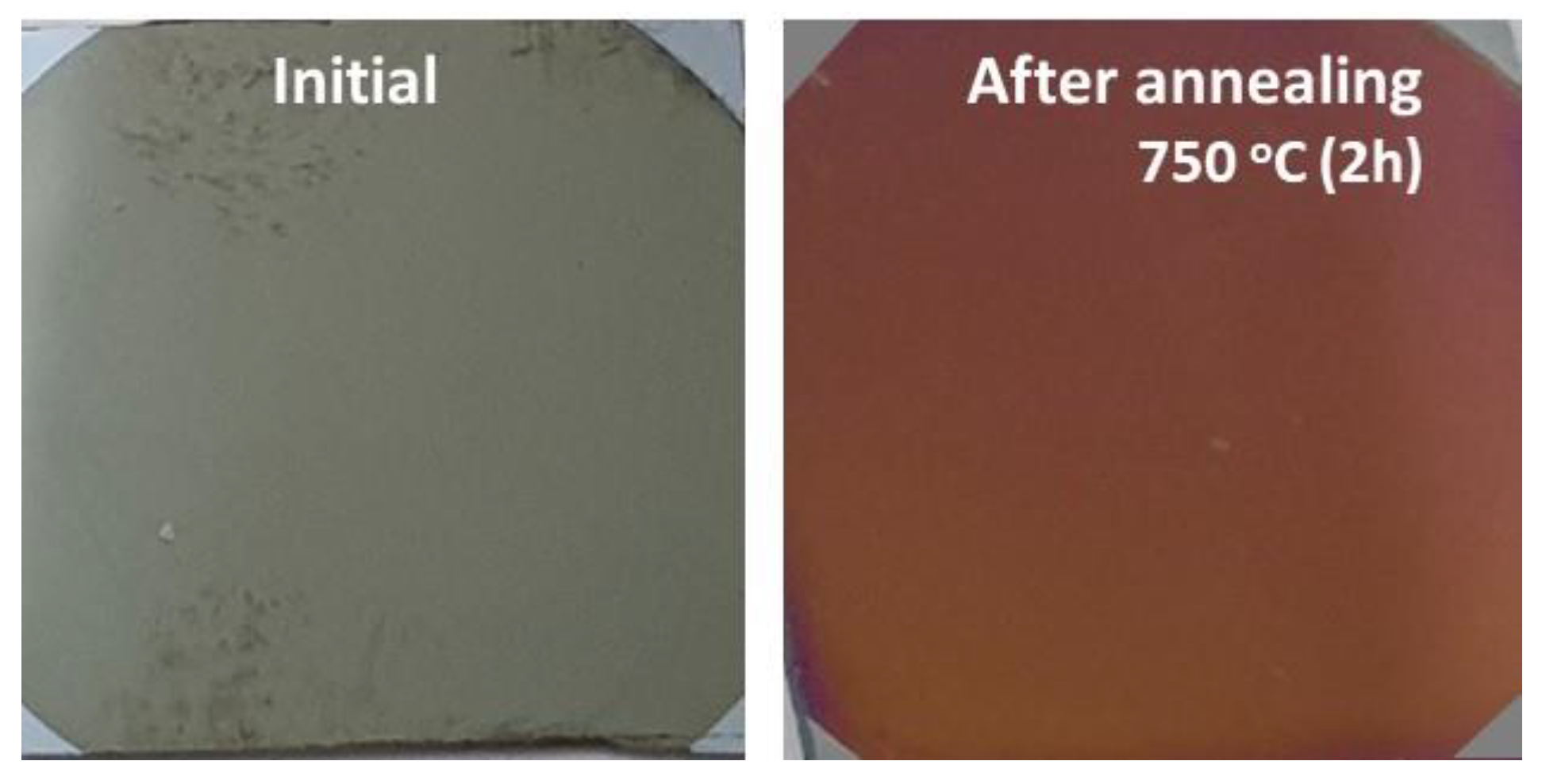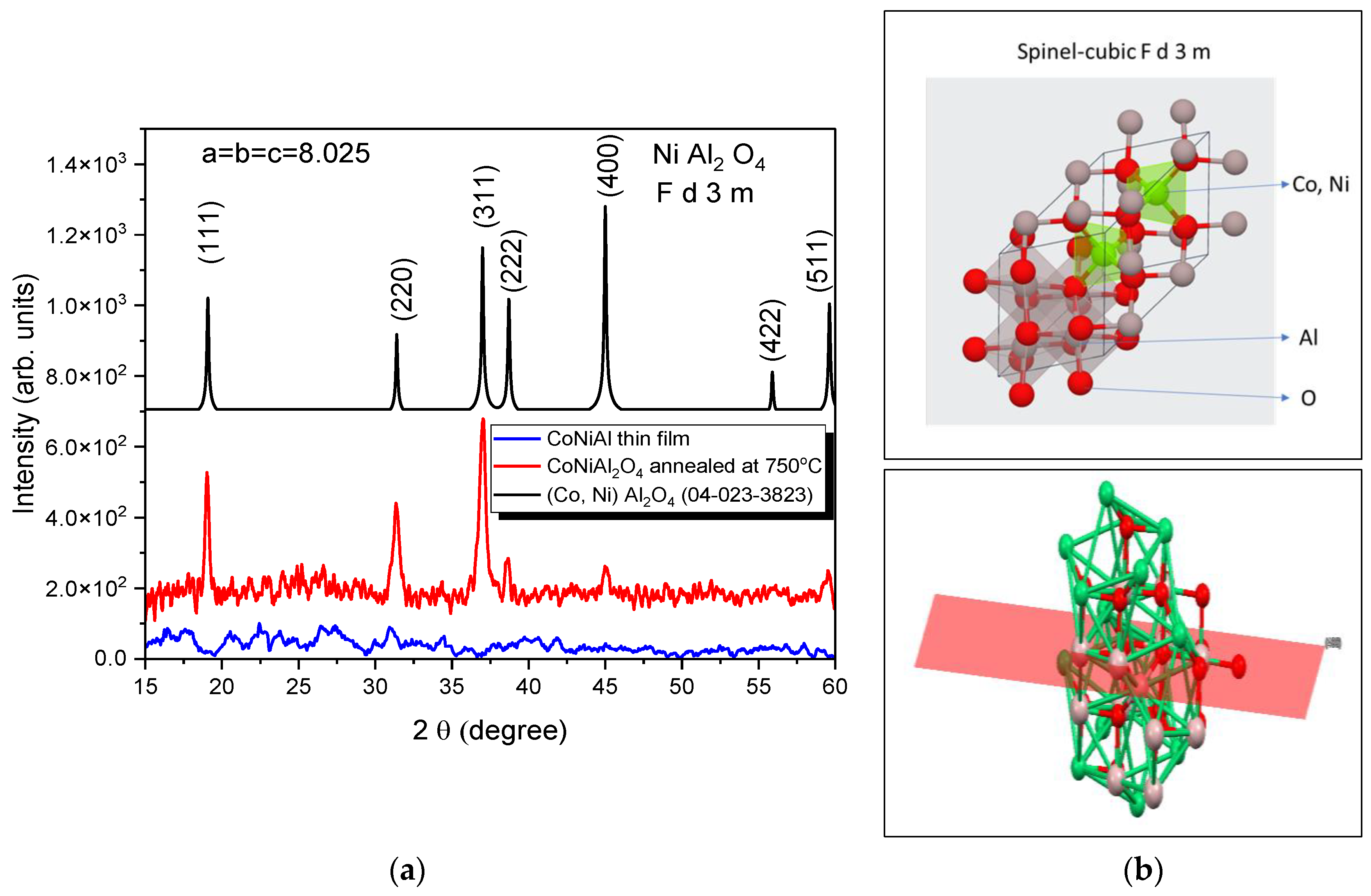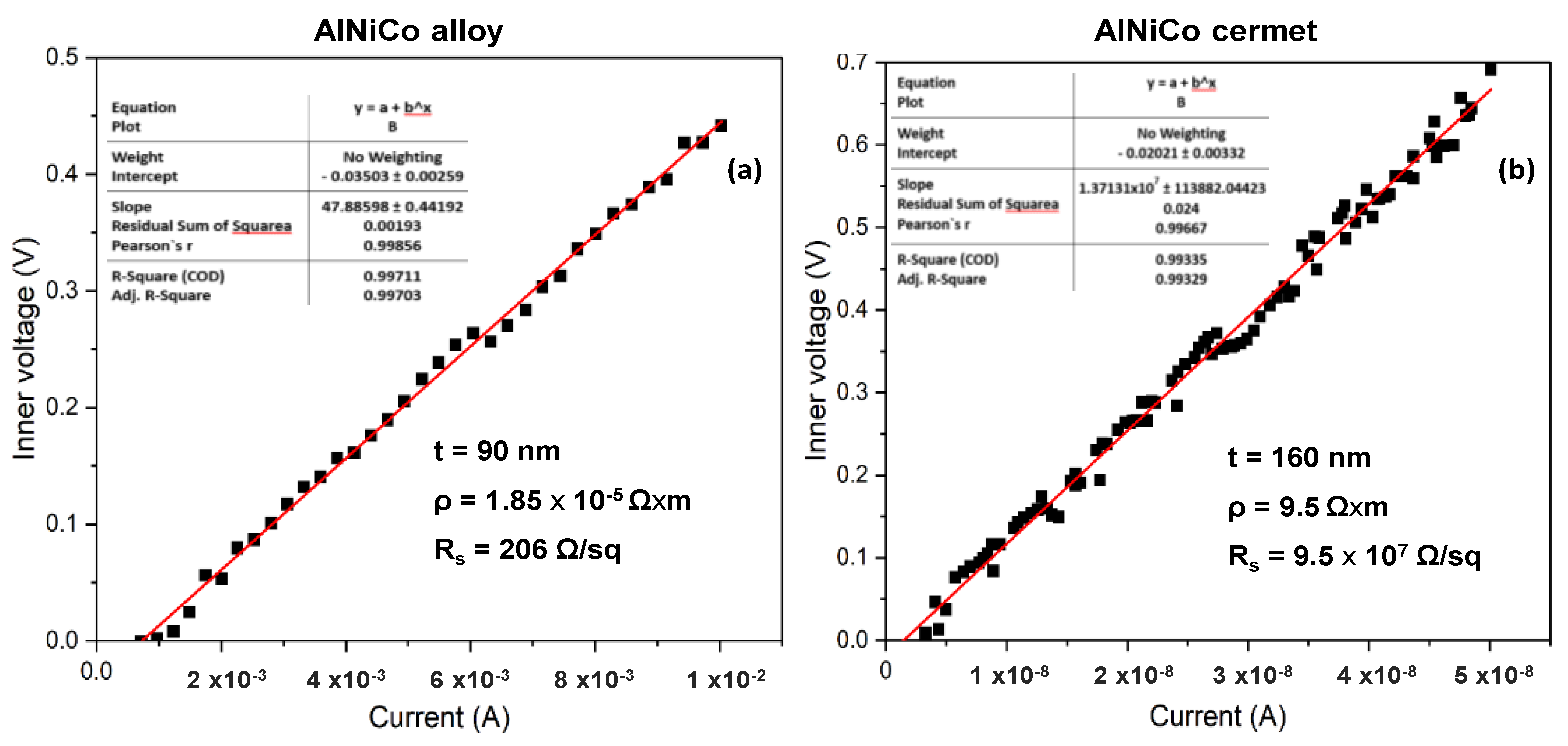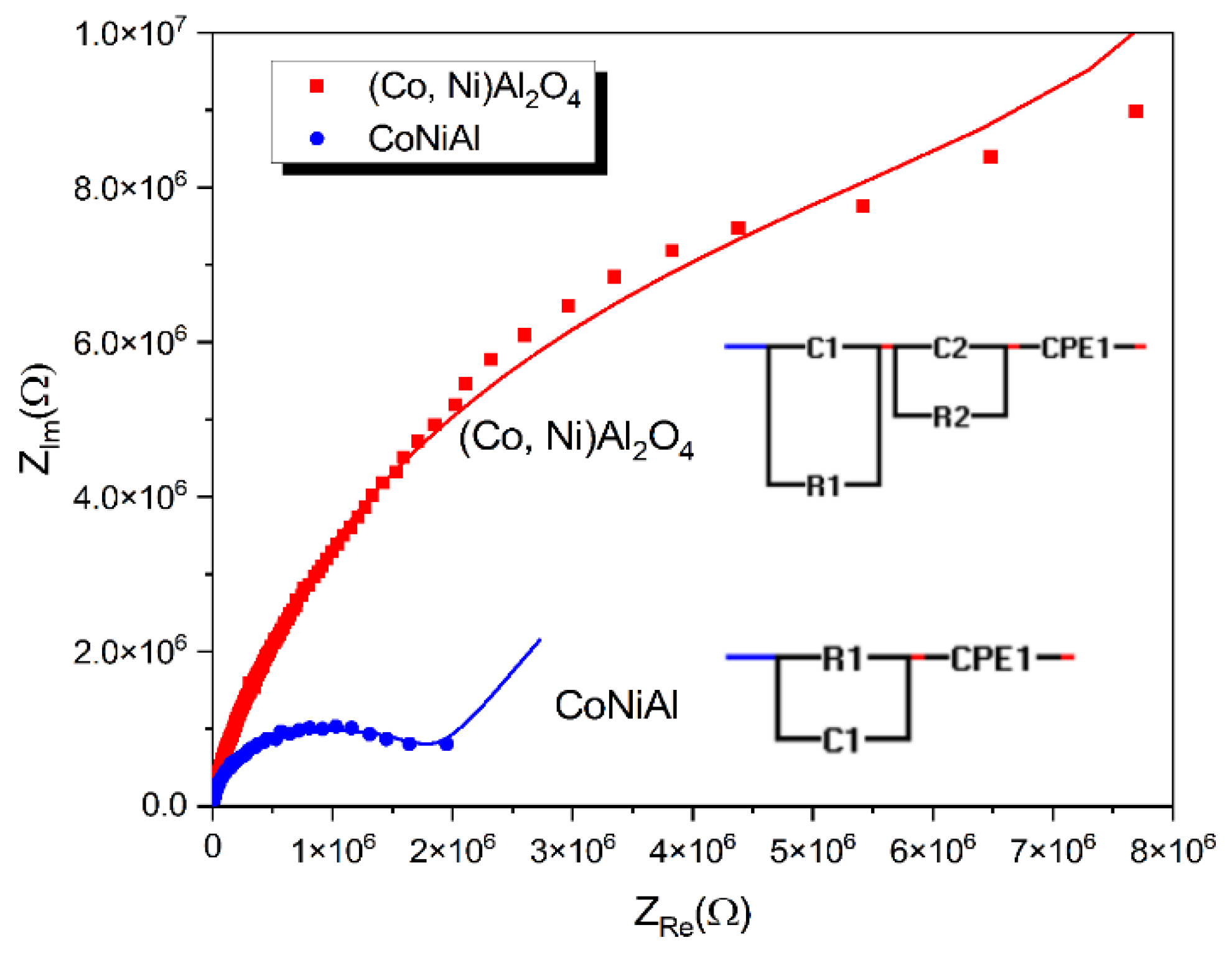Synthesis of Cobalt–Nickel Aluminate Spinels Using the Laser-Induced Thermionic Vacuum Arc Method and Thermal Annealing Processes
Abstract
1. Introduction
2. Materials and Methods
3. Results
3.1. Structural Analysis (XRD; SEM; EDX)
3.2. Surface Elemental Analysis (SEM/EDX)
3.3. Electrical Measurements
3.4. Dielectric Measurements
4. Discussion
5. Conclusions
Author Contributions
Funding
Acknowledgments
Conflicts of Interest
References
- Iclodean, C.; Varga, B.; Burnete, N.; Cimerdean, D.; Jurchiș, B. Comparison of Different Battery Types for Electric Vehicles. IOP Conf. Ser. Mater. Sci. Eng. 2017, 252, 012058. [Google Scholar] [CrossRef]
- Wang, S.; Jiang, S.P. Prospects of Fuel Cell Technologies. Natl. Sci. Rev. 2017, 4, 163–166. [Google Scholar] [CrossRef]
- Minh, N.Q. Ceramic Fuel Cells. J. Am. Ceram. Soc. 1993, 76, 563–588. [Google Scholar] [CrossRef]
- Vaßen, R.; Simwonis, D.; Stöver, D. Modelling of the Agglomeration of Ni-Particles in Anodes of Solid Oxide Fuel Cells. J. Mater. Sci. 2001, 36, 147–151. [Google Scholar] [CrossRef]
- Mari, D. Cermets, and Hardmetals. In Encyclopedia of Materials: Metals and Alloys; Caballero, F.G., Ed.; Elsevier: Oxford, UK, 2016; pp. 420–424. ISBN 978-0-12-819733-2. [Google Scholar]
- O’Hayre, R.; Barnett, D.M.; Prinz, F.B. The Triple Phase Boundary. J. Electrochem. Soc. 2005, 152, A439. [Google Scholar] [CrossRef]
- Fukui, T.; Ohara, S.; Naito, M.; Nogi, K. Morphology and Performance of SOFC Anode Fabricated from NiO/YSZ Composite Particles. J. Chem. Eng. Jpn. 2001, 34, 964–966. [Google Scholar] [CrossRef]
- Zhu, W.Z.; Deevi, S.C. A Review on the Status of Anode Materials for Solid Oxide Fuel Cells. Mater. Sci. Eng. A 2003, 362, 228–239. [Google Scholar] [CrossRef]
- Primdahl, S.; Mogensen, M. Mixed Conductor Anodes: Ni as Electrocatalyst for Hydrogen Conversion. Solid State Ion. 2002, 152–153, 597–608. [Google Scholar] [CrossRef]
- Jiang, S.P.; Zhang, S.; Zhen, Y.D.; Wang, W. Fabrication and Performance of Impregnated Ni Anodes of Solid Oxide Fuel Cells. J. Am. Ceram. Soc. 2005, 88, 1779–1785. [Google Scholar] [CrossRef]
- Hasan, M.; Drazin, J.; Dey, S.; Castro, R.H.R. Synthesis of Stoichiometric Nickel Aluminate Spinel Nanoparticles. Am. Mineral. 2015, 100, 652–657. [Google Scholar] [CrossRef]
- Kalluri, S.; Seng, K.H.; Guo, Z.; Liu, H.K.; Dou, S.X. Electrospun Lithium Metal Oxide Cathode Materials for Lithium-Ion Batteries. RSC Adv. 2013, 3, 25576–25601. [Google Scholar] [CrossRef]
- Ouahdi, N.; Guillemet, S.; Demai, J.J.; Durand, B.; Er Rakho, L.; Moussa, R.; Samdi, A. Investigation of the Reactivity of AlCl3 and CoCl2 toward Molten Alkali-Metal Nitrates in Order to Synthesize CoAl2O4. Mater. Lett. 2005, 59, 334–340. [Google Scholar] [CrossRef][Green Version]
- Markin, T.L.; Bones, R.J.; Dell, R.M. High Temperature Solid Electrolyte Fuel Cells. In Superionic Conductors; Mahan, G.D., Roth, W.L., Eds.; Springer: Boston, MA, USA, 1976; pp. 15–35. ISBN 978-1-4615-8789-7. [Google Scholar]
- Ribeiro, N.F.P.; Neto, R.C.R.; Moya, S.F.; Souza, M.M.V.M.; Schmal, M. Synthesis of NiAl2O4 with High Surface Area as Precursor of Ni Nanoparticles for Hydrogen Production. Int. J. Hydrog. Energy 2010, 35, 11725–11732. [Google Scholar] [CrossRef]
- Li, D.; Li, Y.; Liu, X.; Guo, Y.; Pao, C.-W.; Chen, J.-L.; Hu, Y.; Wang, Y. NiAl2O4 Spinel Supported Pt Catalyst: High Performance and Origin in Aqueous-Phase Reforming of Methanol. ACS Catal. 2019, 9, 9671–9682. [Google Scholar] [CrossRef]
- Kurien, S.; Mathew, J.; Sebastian, S.; Potty, S.N.; George, K.C. Dielectric Behavior and Ac Electrical Conductivity of Nanocrystalline Nickel Aluminate. Mater. Chem. Phys. 2006, 98, 470–476. [Google Scholar] [CrossRef]
- Mohammadpour Amini, M.; Torkian, L. Preparation of Nickel Aluminate Spinel by Microwave Heating. Mater. Lett. 2002, 57, 639–642. [Google Scholar] [CrossRef]
- Tangcharoen, T.; T-Thienprasert, J.; Kongmark, C. Effect of Calcination Temperature on Structural and Optical Properties of MAl2O4 (M = Ni, Cu, Zn) Aluminate Spinel Nanoparticles. J. Adv. Ceram. 2019, 8, 352–366. [Google Scholar] [CrossRef]
- Eshghi, J.; Haghighi, M.; Sajjadi, S.M. Sol-Gel Synthesis of Co-W Promoted NiAl2O4 Spinel Nanocatalyst Used in Combined Reforming of Methane: Influence of Tungsten Content on Catalytic Activity and Stability. Ceram. Int. 2019, 45, 4596–4608. [Google Scholar] [CrossRef]
- Vladoiu, R.; Mandes, A.; Dinca, V.; Ciupina, V.; Matei, E.; Polosan, S. The Synergistic Effect of the Laser Beam on the Thermionic Vacuum Arc Method for Titanium-Doped Chromium Thin Film Deposition. Coatings 2022, 12, 470. [Google Scholar] [CrossRef]
- Vladoiu, R.; Mandes, A.; Dinca, V.; Kudrna, P.; Tichý, M.; Polosan, S. Magnesium-Silver Cathodes for Efficient Charge Injection into Organic Light Emitting Diodes Deposited by LTVA Method. J. Alloys Compd. 2021, 869, 159364. [Google Scholar] [CrossRef]
- Vladoiu, R.; Tichý, M.; Mandes, A.; Dinca, V.; Kudrna, P. Thermionic Vacuum Arc—A Versatile Technology for Thin Film Deposition and Its Applications. Coatings 2020, 10, 211. [Google Scholar] [CrossRef]
- Musa, G.; Mustata, I.; Blideran, M.; Ciupina, V.; Vladoiu, R.; Prodan, G.; Vasile, E.; Ehrich, H. Thermionic Vacuum Arc—New Technique for High Purity Carbon Thin Film Deposition. Acta Phys. Slovaca 2005, 55, 417–421. [Google Scholar]
- Vladoiu, R.; Ciupina, V.; Lungu, C.; Bursikova, V.; Musa, G. Thermoionic Vacuum Arc (TVA) Deposited Tungsten Thin Film Characterization. J. Optoelectron. Adv. Mater. 2006, 8, 71–73. [Google Scholar]
- Musa, G.; Vladoiu, R.; Ciupina, V.; Lungu, C.; Mustata, I.; Pat, S.; Akan, T.; Ekem, N. Characteristics of Boron Thin Films Obtained by TVA Technology. J. Optoelectron. Adv. Mater. 2006, 8, 617–620. [Google Scholar]
- Vladoiu, R.; Mandes, A.; Dinca, V.; Prodan, G.; Kudrna, P.; Tichý, M. Magnesium Plasma Diagnostics by Heated Probe and Characterization of the Mg Thin Films Deposited by Thermionic Vacuum Arc Technology. Plasma Sources Sci. Technol. 2015, 24, 035008. [Google Scholar] [CrossRef]
- Ekem, N.; Musa, G.; Pat, S.; Balbağ, M.; Cenik, I.; Vladoiu, R. Carbon Thin Film Deposition by Thermionic Vacuum Arc (TVA). J. Optoelectron. Adv. Mater. 2008, 10, 672–674. [Google Scholar]
- Mandes, A.; Vladoiu, R.; Dinca, V.; Prodan, G. Binary C-Ag Plasma Breakdown and Structural Characterization of the Deposited Thin Films by Thermionic Vacuum Arc Method. IEEE Trans. Plasma Sci. 2014, 42, 2806–2807. [Google Scholar] [CrossRef]
- Vladoiu, R.; Ciupina, V.; Contulov, M.; Mandes, A.; Dinca, V.; Prodan, G.; Lungu, C.P. Structure and Tribological Properties of Carbon Based Nanocomposites Grown by TVA Method. J. Optoelectron. Adv. Mater. 2010, 12, 553–556. [Google Scholar]
- Vladoiu, R.; Aurelia, M.; Dinca, V.; Balasoiu, M.; Soloviov, D.; Turchenko, V. Synthesis and Characterization of Complex Nanostructured Thin Films Based on Titanium for Industrial Applications. Materials 2020, 13, 399. [Google Scholar] [CrossRef]
- Vladoiu, R.; Mandes, A.; Dinca, V.; Prodan, G.; Kudrna, P.; Tichý, M. Plasma Diagnostics and Characterization of the Mg and Mg–Zn Thin Films Deposited by Thermionic Vacuum Arc (TVA) Method. Vacuum 2019, 167, 129–135. [Google Scholar] [CrossRef]
- Mandes, A.; Vladoiu, R.; Prodan, G.; Dinca, V.; Porosnicu, C.; Dinca, P. The Properties of Binary and Ternary Ti Based Coatings Produced by Thermionic Vacuum Arc (TVA) Technology. Coatings 2018, 8, 114. [Google Scholar] [CrossRef]
- Dinca-Balan, V.; Vladoiu, R.; Mandes, A.; Prodan, G. Correlation Study of Nanocrystalline Carbon Doped Thin Films Prepared by a Thermionic Vacuum Arc Deposition Technique. J. Phys. D Appl. Phys. 2017, 50, 435305. [Google Scholar] [CrossRef]
- Bredar, A.R.C.; Chown, A.L.; Burton, A.R.; Farnum, B.H. Electrochemical Impedance Spectroscopy of Metal Oxide Electrodes for Energy Applications. ACS Appl. Energy Mater. 2020, 3, 66–98. [Google Scholar] [CrossRef]
- Vadhva, P.; Hu, J.; Johnson, M.J.; Stocker, R.; Braglia, M.; Brett, D.J.L.; Rettie, A.J.E. Electrochemical Impedance Spectroscopy for All-Solid-State Batteries: Theory, Methods and Future Outlook. ChemElectroChem 2021, 8, 1930–1947. [Google Scholar] [CrossRef]
- Available online: www.webelements.com (accessed on 6 October 2022).
- Yadav, T.P.; Mukhopadhyay, N.K.; Tiwari, R.S.; Srivastava, O.N. Synthesis of Nanocrystalline (Co, Ni)Al2O4 Spinel Powder by Mechanical Milling of Quasicrystalline Materials. J. Nanosci. Nanotechnol. 2007, 7, 575–579. [Google Scholar] [CrossRef]
- Roelofsen, J.N.; Peterson, R.C.; Raudsepp, M. Structural Variation in Nickel Aluminate Spinel (NiAl2O4). Am. Mineral. 1992, 77, 522–528. [Google Scholar]
- Daneu, N.; Rečnik, A.; Yamazaki, T.; Dolenec, T. Structure and Chemistry of (111) Twin Boundaries in MgAl2O4 Spinel Crystals from Mogok. Phys. Chem. Miner. 2007, 34, 233–247. [Google Scholar] [CrossRef]
- Fuchs, K. The Conductivity of Thin Metallic Films According to the Electron Theory of Metals. Math. Proc. Camb. Philos. Soc. 1938, 34, 100–108. [Google Scholar] [CrossRef]
- Sondheimer, E.H. The Mean Free Path of Electrons in Metals. Adv. Phys. 1952, 1, 1–42. [Google Scholar] [CrossRef]
- Zhang, Z.; Wang, Y.; Zu, G.; Cao, Z.; Liu, J.; Wang, C. Effect of TiN Content on Properties of NiFe2O4-Based Ceramic Inert Anode for Aluminum Electrolysis. Int. J. Appl. Ceram. Technol. 2021, 18, 1114–1124. [Google Scholar] [CrossRef]
- Peters, C.; Weber, A.; Butz, B.; Gerthsen, D.; Ivers-Tiffée, E. Grain-Size Effects in YSZ Thin-Film Electrolytes. J. Am. Ceram. Soc. 2009, 92, 2017–2024. [Google Scholar] [CrossRef]
- Gerstl, M.; Navickas, E.; Friedbacher, G.; Kubel, F.; Ahrens, M.; Fleig, J. The Separation of Grain and Grain Boundary Impedance in Thin Yttria Stabilized Zirconia (YSZ) Layers. Solid State Ion. 2011, 185, 32–41. [Google Scholar] [CrossRef] [PubMed]






| Parameters | |
|---|---|
| Energy/pulse of laser E (mJ) | 100 |
| Irradiance of the laser IL (GW/cm2) | 20 |
| Base pressure pB (Pa) | 5 × 10−6 |
| Working pressure pW (Pa) | 4.7 × 10−5 |
| Intensity current on the filament IF (A) | 58 |
| Film thickness t (nm) | 145 |
| Time of deposition (s) | 900 |
| Parameter | CoNiAl Alloy | (Co, Ni)Al2O4 Cermet |
|---|---|---|
| C1 | 2.4 pF | 2.7 pF |
| R1 | 1.82 MΩ | 2.2 MΩ |
| C2 | - | 7.3 pF |
| R2 | - | 8.06 MΩ |
| CPE | 980 pF | 16.8 pF |
| β | 0.7 | 0.9 |
Publisher’s Note: MDPI stays neutral with regard to jurisdictional claims in published maps and institutional affiliations. |
© 2022 by the authors. Licensee MDPI, Basel, Switzerland. This article is an open access article distributed under the terms and conditions of the Creative Commons Attribution (CC BY) license (https://creativecommons.org/licenses/by/4.0/).
Share and Cite
Vladoiu, R.; Mandes, A.; Dinca, V.; Matei, E.; Polosan, S. Synthesis of Cobalt–Nickel Aluminate Spinels Using the Laser-Induced Thermionic Vacuum Arc Method and Thermal Annealing Processes. Nanomaterials 2022, 12, 3895. https://doi.org/10.3390/nano12213895
Vladoiu R, Mandes A, Dinca V, Matei E, Polosan S. Synthesis of Cobalt–Nickel Aluminate Spinels Using the Laser-Induced Thermionic Vacuum Arc Method and Thermal Annealing Processes. Nanomaterials. 2022; 12(21):3895. https://doi.org/10.3390/nano12213895
Chicago/Turabian StyleVladoiu, Rodica, Aurelia Mandes, Virginia Dinca, Elena Matei, and Silviu Polosan. 2022. "Synthesis of Cobalt–Nickel Aluminate Spinels Using the Laser-Induced Thermionic Vacuum Arc Method and Thermal Annealing Processes" Nanomaterials 12, no. 21: 3895. https://doi.org/10.3390/nano12213895
APA StyleVladoiu, R., Mandes, A., Dinca, V., Matei, E., & Polosan, S. (2022). Synthesis of Cobalt–Nickel Aluminate Spinels Using the Laser-Induced Thermionic Vacuum Arc Method and Thermal Annealing Processes. Nanomaterials, 12(21), 3895. https://doi.org/10.3390/nano12213895






